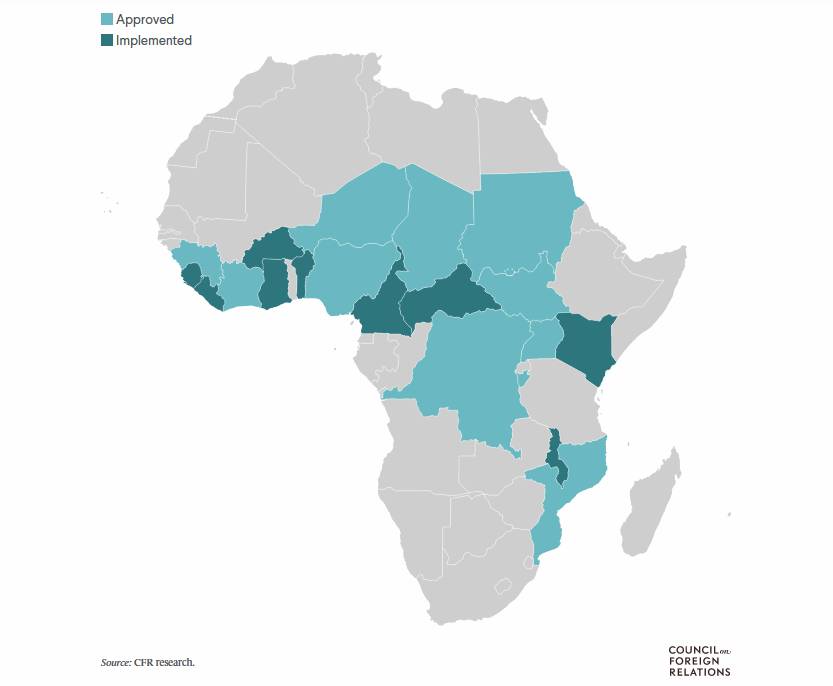Share
Two new malaria vaccines offer Africans the hope of finally eradicating a disease that has long plagued them disproportionately. Experts say vaccination is just one tool in a much broader fight.
How does malaria affect Africa?
More than 95 percent of the world’s malaria cases are concentrated in sub-Saharan Africa. In 2022, the mosquito-borne disease killed roughly 580,000 people in the region, according to the World Health Organization (WHO). The vast majority of these deaths were children under five.
Where Malaria Cases Are Highest
Malaria cases in sub-Saharan Africa, 2021
 How much of a threat is the disease?
How much of a threat is the disease?
Malaria is preventable and treatable with the right interventions. The world has had success in stamping out the disease in areas where it was historically endemic, such as in most places in Asia, the Americas, and Europe. These efforts were made possible with guidance from international health bodies such as the WHO, strong financing, and wide-scale deployment of innovative measures such as treated nets, insecticide spraying, and providing rapid diagnostic tests.
Malaria-related mortality worldwide has declined by 90 percent since 1900. Because of these gains, experts now hope that the disease can be eradicated as early as 2050.
But progress on eradication has eroded in recent years, experts say, due to factors including financial and logistical disruptions caused by the COVID-19 pandemic, climate change, population movement, and rising insecticide and diagnostic resistance, meaning malaria is increasingly evading detection tests. “We’re facing something of a perfect storm of threats at the moment,” says Melanie Renshaw, principal director of the African Leaders Malaria Alliance, a coalition of officials from African governments and the African Union who are working to eliminate malaria by 2030.
However, Africa could be at a tipping point in its hard-fought battle against the disease. Two new, revolutionary vaccines—RTS,S and R21—are being scaled out across the continent, raising hopes that this effort can revive progress on eliminating the disease.
What are the new malaria vaccines?

A child receives a shot during the launch of the world’s first malaria vaccine program, in Gisambai, Kenya.
RTS,S. Approved by the WHO in 2021, the vaccine was developed over thirty years by British drugmaker GSK and the U.S. army. A trial of RTS,S in Ghana, Kenya, and Malawi has seen two million children vaccinated since 2019. The success of this effort paved the way for a coalition that includes WHO; Gavi, the Vaccine Alliance; and African governments to launch a first-of-its-kind initiative to deploy eighteen million RTS,S vaccines this year to the twelve countries with the highest transmission levels. As of July, more than 4.3 million doses have been doled out to eight countries.
R21. In late 2023, the WHO approved this vaccine developed by Oxford University and U.S. biotech firm Novavax, and it is now being manufactured by the Serum Institute of India. R21 made its debut in May, with more than 163,000 doses sent to the Central African Republic (CAR). Multiple countries are now preparing for their own R21 shipments, including Chad, Democratic Republic of Congo, Ivory Coast, Mozambique, Nigeria, South Sudan, and Uganda.
Already, more than thirty African countries have expressed interest in introducing the vaccines into routine immunization programs; twenty-two have applied to the vaccine coalition program and been approved to begin vaccinations as more doses become available. Still, health experts note that the rollout of any new vaccination program is a major undertaking that typically takes a lot of work to both stimulate and meet demand.
Countries Adopting the Malaria Vaccines
Countries that have approved or implemented either the RTS,S or R21 vaccine
 How do the vaccines work?
How do the vaccines work?
The vaccines are currently only approved for children ages five months or older, though health experts expect to see them offered to more demographics down the line. Full immunization requires four rounds of the shot, so the millions of vaccines promised could only fully protect about one quarter as many children as there are total doses. Three rounds provide some protection.
A full dose of the vaccine has been shown to prevent malaria in at least 40 percent of children. While this rate sounds low, the vaccines can bring malaria rates down even further when combined with prevention methods such as mosquito nets, insecticide, and effective diagnostic testing: Gavi reported at the beginning of this year that the vaccines can prevent around 75 percent of malaria episodes when given seasonally in areas of high transmission. Some studies even rate the vaccines as more than 90 percent effective, W. Scott Gordon, the head of Gavi’s malaria vaccine program, tells CFR.
The success of the combined interventions goes to show that the vaccine is a breakthrough development in the malaria eradication fight, it is one tool in a toolbox of many, experts say. Prevention and testing technologies provided via partnerships between local, national, and international groups have turned out major wins: increased mosquito net accessibility is calculated to have averted as many as thirteen million malaria cases between 2019 and 2022 alone.
What are the challenges?
Millions of children in Africa are vulnerable to malaria and eligible for these vaccines, so the need is extraordinary: the WHO expects a demand of up to sixty million doses annually by 2026, rising to one hundred million by 2030. Ramping up production of these new vaccines will require a wealth of resources and financing that draws on government incentives. Experts say the challenge does not lie in the process of production, but in garnering the financial support to meet demand on the ground.
“We don’t actually see that there are significant production barriers or supply barriers to being able to reach the higher transmission populations in Africa,” Gordon says. “But making sure that we have broader public health support and financial support for these programs is really critical.” Malaria programs in Africa are highly dependent on funding from governments and other global partners, such as philanthropies, and faltering funds in recent years have put these programs to the test.
Because malaria is expanding its geographic footprint, vaccine demand is expected to rise in other parts of the world, underscoring the need for increased manufacturing everywhere, but especially in the areas where it is most needed. The WHO panel on malaria vaccine allocation aims to prioritize manufacturing on the African continent specifically to ensure vaccine equity as the disease spread grows, says Rose Leke, the panel’s cochair.
Vaccine equity also means working to ensure that some African countries aren’t left behind as they were in response to the COVID-19 pandemic. WHO Director General Tedros Adhanom Ghebreyesus, the first African to lead the organization, condemned the COVID drug rollout as “vaccine apartheid,” where Africans were pushed to the bottom of the priority list. Some experts have said that building Africa’s capacity to produce its own vaccines should be a priority. “During COVID, we saw that Africa was at the back of the queue. The best way to secure supply is to make it yourself,” Leke says.
Source: https://www.cfr.org/


